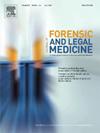走向人类腐烂阶段识别的自动化:一种人工智能方法
IF 1.2
4区 医学
Q3 MEDICINE, LEGAL
引用次数: 0
摘要
确定分解阶段(SOD)是估计死后时间间隔的必要步骤之一,这可能有助于识别人类遗骸。目前使用的是劳动密集型的人工评分方法,但这些方法比较主观,不适合新兴的大规模人体分解照片档案收藏。本研究探讨了Megyesi和Gelderman提出的两种人体分解评分方法使用人工智能(AI)实现自动化的可行性。我们评估了两种流行的深度学习模型,Inception V3和Xception,通过在大型人体分解图像数据集上训练它们对不同解剖区域(包括头部、躯干和四肢)的SOD进行分类。此外,进行了一项解释器研究,以评估人工智能模型与人类法医鉴定SOD的可靠性。Xception模型的分类性能最好,宏观平均F1得分为。878年,。881,和。702的头部,躯干和四肢在预测Megyesi的sod时,和。872年,。875,和。在预测格尔德曼的sod时,头部,躯干和四肢分别是76。解释器的研究结果支持人工智能在与人类专家相当的可靠性水平上确定SOD的能力。这项工作证明了人工智能模型在人类分解图像的大型数据集上训练的潜力,可以自动进行SOD分类。本文章由计算机程序翻译,如有差异,请以英文原文为准。
Towards automation of human stage of decay identification: An artificial intelligence approach
Determining the stage of decomposition (SOD) is one of the first steps necessary to estimate the postmortem interval, which may aid in identifying human remains. Currently, labor-intensive manual scoring methods are used for this purpose, but they are subjective and do not scale for the emerging large-scale archival collections of human decomposition photos. This study explores the feasibility of automating two human decomposition scoring methods proposed by Megyesi and Gelderman using artificial intelligence (AI). We evaluated two popular deep learning models, Inception V3 and Xception, by training them on a large dataset of human decomposition images to classify the SOD for different anatomical regions, including the head, torso, and limbs. Additionally, an interrater study was conducted to assess the reliability of the AI models compared to human forensic examiners for SOD identification. The Xception model achieved the best classification performance, with macro-averaged F1 scores of .878, .881, and .702 for the head, torso, and limbs when predicting Megyesi's SODs, and .872, .875, and .76 for the head, torso, and limbs, respectively, when predicting Gelderman's SODs. The interrater study results supported AI's ability to determine the SOD at a reliability level comparable to a human expert. This work demonstrates the potential of AI models trained on a large dataset of human decomposition images to automate SOD classification.
求助全文
通过发布文献求助,成功后即可免费获取论文全文。
去求助
来源期刊

Journal of forensic and legal medicine
MEDICINE, LEGAL-
CiteScore
2.70
自引率
6.70%
发文量
106
审稿时长
57 days
期刊介绍:
The Journal of Forensic and Legal Medicine publishes topical articles on aspects of forensic and legal medicine. Specifically the Journal supports research that explores the medical principles of care and forensic assessment of individuals, whether adult or child, in contact with the judicial system. It is a fully peer-review hybrid journal with a broad international perspective.
The Journal accepts submissions of original research, review articles, and pertinent case studies, editorials, and commentaries in relevant areas of Forensic and Legal Medicine, Context of Practice, and Education and Training.
The Journal adheres to strict publication ethical guidelines, and actively supports a culture of inclusive and representative publication.
 求助内容:
求助内容: 应助结果提醒方式:
应助结果提醒方式:


